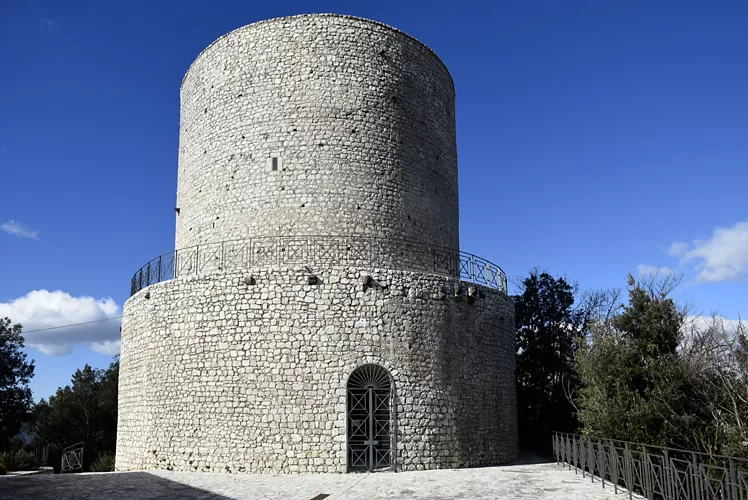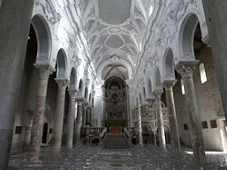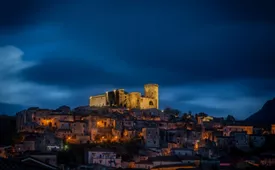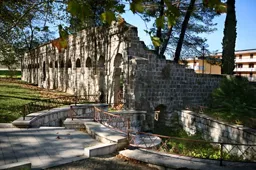This content was automatically translated. View the original text.




Overview
In the Titerno valley, between nature, archaeology and the Middle Ages
For Via Francigena and serious History enthusiasts, today we are in the Sannio region, specifically in Faicchio, in the province of Benevento. This medieval village, nestled in the Matese Regional Park, has quid that will make you fall in love and return whenever you get the chance.
This is where the Titerno, the river that, before flowing into the Volturno, carves gorges and canyons in this valley between rock walls, an ideal training ground for extreme sports enthusiasts.
A natural amphitheatre where the Roman bridge named after Quintus Fabius Maximus, known for his war tactics as “cunctator”, the delayer, still stands: according to legend, the Roman dictator crossed it in 217 BC to halt Hannibal's advance during the Second Punic War.
The Fabio Massimo Bridge, a page of history
Intended to connect those valleys with the Matese massif, the bridge actually has pre-Roman origins, Samnite to be precise. Originally, a wooden footbridge was placed on the rocky bank of the riverbank for crossing, which naturally offered little resistance to flooding, as well as being easily perishable. Architecturally speaking, the later Roman bridge, made of terracotta, stone and tuff, 12 metres long and 13 metres high, consists of three asymmetrical arches built in successive phases: a work that has adapted over time to different environmental and civil requirements and that accounts for the evolution of construction techniques and materials developed by the Romans. But the bridge is certainly not Faicchio's only attraction...
The ducal castle and the convict trap
Dominating the historical centre of Faicchio is the ducal castle that, with its trapezoidal shape and mighty cylindrical towers, is reminiscent of the Maschio Angioino, the most 'famous' relative of Naples. Built in the 12th century by the Norman counts Sanframondo in a strategically elevated position, between the Acero and Gioia mountains, so as to dominate the course of the Titerno and its valley, it was renovated in 1612, as the epigraph on the entrance portal reads, by the Neapolitan nobleman Gabriele De Martino, whose family held the castle until the suppression of feudal rights. The last restoration, which saved the manor from ruin, was in 1962 by the new owners, the Fragola family.
For thrill-seekers: the castle's dungeons are deep and impassable, but on the ground floor you can visit the prison room, a dark but well-preserved cavern whose walls hold ancient inscriptions, possibly the work of prisoners in chains. There is also a legend that the castle chapel housed a painting of St Barbara: after the religious services, the condemned man was made to kiss it. He, in approaching the painting, unbeknownst to him, placed his feet on a trapdoor hidden in the floor, still existing today, which opened treacherously, swallowing the unfortunate man.
The wonder of the Samnite megalithic walls
If you love walking, choose a cool day to climb, via a Cai (Italian Alpine Club) trail, to the summit of Mount Acero, a 732-metre-high relief that rises isolated in the valley. Here you can take a closer look at the celebrated megalithic walls, evidence of the long and tenacious rule of the Samnites in these surroundings. The walls, which date back to the 4th century BC, are the remains of an immense fortified wall: still the largest, with its 3 kilometres and an average height of 3.5 metres, and the best preserved of the Samnite period.
This is all that remains of the great work of fortification that is counted among the greatest examples of Samnite military architecture: it guaranteed the security and defence of the Arce, while the main activities, farming and trade, took place in the valley. Made of dry-assembled blocks of limestone, these polygonal or “cyclopean” walls, which stretch along an irregularly quadrangular perimeter, belonged to a larger and more complex defence system that the Samnites extended to the entire Apennine territory and which enclosed settlements of various sizes. At the top of the mountain, there is a statue of the Redeemer, from where you can take in the entire surrounding area.
Land of saints and salami
A few kilometres from Faicchio is the contrada Fontanavecchia, named after an ancient spring that supplied the inhabitants of the area. It is precisely in this locality, near the Church of St. Mary of Constantinople, that the entrance to an ancient Roman underground aqueduct dating back to the 3rd century BC can still be admired and a stretch of about one kilometre can still be travelled.
After the excursions and historical-artistic inspections, it is worth mentioning that Faicchio, the seat of the bishop's residence for a brief period, is also known as the 'land of saints and salami', a motto that alludes to the art of pork butchery, which reaches authentic levels of excellence here.
In fact, it is one of the few places in Campania where it is possible to breed the prestigious black pig, whose meat is used to produce, through a refined process, cured meats with an incomparable taste. Culatello del Matese also deserves a mention, its special processing and ageing process differentiates it from traditional culatello and gives it organoleptic characteristics appreciated by connoisseurs.
Find out more
https://sannio.guideslow.it/itinerari/sannio-alle-pendici-del-matese-1-faicchio